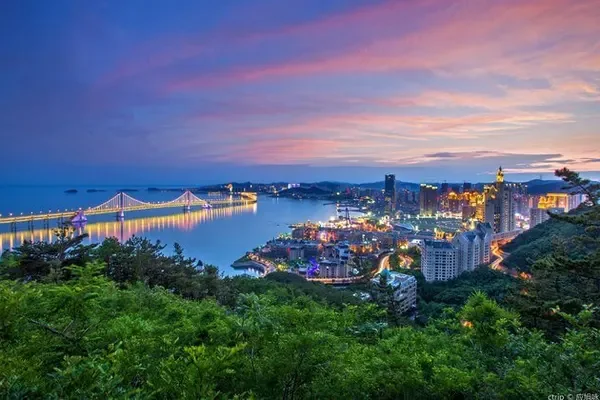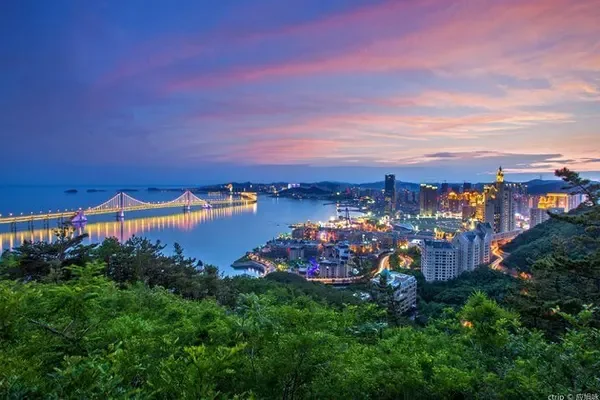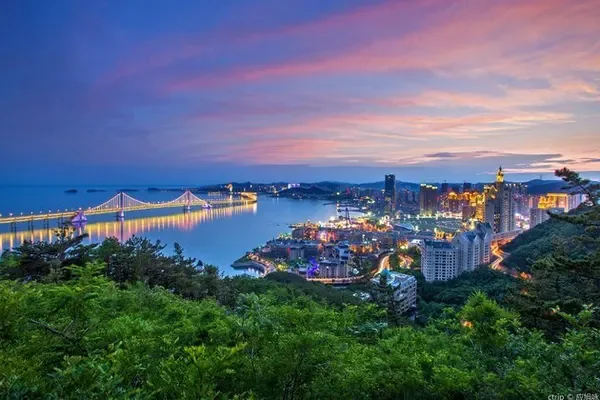There is a famous Langya Mountain in Yi County, Hebei Province, which is famous for the movie "Five Heroes of Langya Mountain". It is also this movie that made reporters have long been fond of this place, especially because they admired the five heroes who fought bravely against the Japanese invaders here during the Anti-Japanese War, so they always thought of visiting here. Unexpectedly, on March 28 and June 3, 2007, the reporter had the honor to visit here twice in the same year.

The first time I came to Langya Mountain was with Mr. Cao Qun, President of Beijing Aiche Global Group, to inspect the Yixian Red Tour self-driving tour route. Accompanied by Liu Xuejun, then director of Yixian Tourism Bureau, I went to Langya Mountain for the first time. On the way to climb the mountain, Director Liu Xuejun talked about the tourism resources of Yi County.

Yi County has a long history, profound cultural heritage, good ecological environment, and rich tourism resources. There are only 57 national, provincial, and county-level cultural relics protection units. The main tourist attractions are: Langya Mountain, Qingxi Tomb, Yanxiadu, Jingke Pagoda, South Lake, Bauhinia Pass, Tao Te Ching Building, Long Lake, Hongya Mountain, Yunmeng Mountain, Manchu Style Village, Warring States Cultural City, etc.

Among them, 4 Qingxi Mausoleums, Yanxiadu, Zijingguan, and Tao Te Ching Building are national key cultural relics protection units. In addition to the above landscapes, there are twin pagodas in Shuangta Nunnery, novel-shaped Pagoda of Thousand Buddhas, Prince Pagoda built for Prince Yan, Yunmeng Mountain with emerald clouds, Kongshan Moonwatching and so on.

The second time I came to Langya Mountain was to participate in the "National Fitness and Olympic Games 2007 National Mountaineering and Fitness Conference Langya Mountain Mountaineering Competition and Hebei Province Series Tourism Mountaineering Opening Ceremony".

At that time, the warm and jubilant scene at the opening ceremony and the reunion with Wang Xiaguang, a reporter from the Sports Department of the People's Daily, in August 1997, ten years after his trip to Tibet, left a deep memory. Although the two visits to Langya Mountain were not long apart, each time I came here I left different memories.

To climb Langya Mountain, you can hike along the mountain road, or take a cable car to the mountain, and then walk a section of the mountain road to reach the top of the mountain. Langya Mountain is 1105 meters above sea level. It is one of the 100 classic red scenic spots in the country, one of the 30 national red tourist boutique routes, and the patriotic education base in Hebei Province. In 2006, it was selected by CCTV "Perfect Holiday" together with Baiyangdian and Ranzhuang As one of the top ten tourist routes in the country, it is now a national 4A-level scenic spot.

Langya Mountain, formerly known as Langshan Mountain, got its name because the son of the crown prince Liu Shi took refuge here to avoid the "Prison of Witchcraft" during Emperor Wu of the Han Dynasty. Emperor Wudi of the Western Han Dynasty became ill in his later years. He suspected that his left and right sides were caused by witchcraft (buried puppets and cursed to harm people), involving relatives such as the queen, prince, and princess. At the foot of Langshan Mountain, there was originally a stele for worshiping Xilang Shanjun (grandson of Emperor Wu of the Han Dynasty) and his son General Chufeng, father and son, Langshan Jun Temple, and General Chufeng Temple in the first year of Taikang in the Western Jin Dynasty (280).

Lang and wolf are homonyms, also known as Langshan. Because of the towering peaks and the jagged dangerous peaks that look like wolf teeth, it is also known as Langya Mountain. It is one of the ten scenic spots in ancient Yizhou and one of the eight scenic spots in the ancient city of Baoding. There are not only natural wonders such as Fengdong Stone, Xianren Bridge, and Nantianmen on the mountain, but also many cultural relics and historic sites such as Laojuntang, Sanchu Church, and Cangu Temple.

On September 25, 1941, in order to cover the evacuation of the troops, the five warriors would rather die than submit to the approaching Japanese and puppet troops. They destroyed their guns and jumped off the cliff tens of feet deep without hesitation. Make Langya Mountain famous both at home and abroad.

Langya Mountain is not only a mountain of heroes, but also a famous historical and cultural mountain and a mountain of green ecology. It is now a national forest park, a patriotic education base, and a national red tourism hotline scenic spot.

During the Anti-Japanese War, Langya Mountain was a famous anti-Japanese base. After the five warriors jumped off the cliff, Ma Baoyu, Hu Delin, and Hu Fucai sacrificed their lives for the country. In order to commemorate the martyrs, remember the history, and love China, the Langya Mountain Scenic Area is open to tourists free of charge on September 25 every year on the Memorial Day of the Five Warriors of Langya Mountain (Ma Baoyu, Ge Zhenlin, Song Xueyi, Hu Delin, Hu Fucai). "The majestic Yanshan Mountain is high, and the water is cold and easy. Five heroes, the mighty Langya Mountain."

The main peak of Langya Mountain, Lianhua Peak (Big Lotus Petal), is 1105 meters above sea level. It is located in the west of Langya Mountain, Cangutuo in the east, and Laojuntang in the north between Qipantuo and Cangutuo. Three defiles on top of the peaks. Yanwang Xiantai is in the northeast. In the southwest of Qipantuo, there are Zhongjun Mountain and Mount Emei (also known as Qimei Mountain "Yi County Chronicle Draft"). In the early morning or at dusk, standing on the Baoding City Tower, you can see the majestic Langya Mountain as far as hundreds of miles away.

Qipantuo is the place where the five heroes fought against the Japanese invaders. It is one of the main peaks of Langya Mountain. According to the "Yixian Chronicles" of the Republic of China: "Qipantuo is 95 miles southwest of Yixian County, Langshan (Lao Jun) To the west of the Pocket Peak where the hall is located, there are several high peaks around, and you can enter with a single path. There are stone chessboards on it, and there are three pools with endless clear springs." The mountains are all ancient battlefields. Climbing from Xishuizhai, you can reach Xitianmen. The mountains on both sides of the path are like knives and axes, and the stalagmites are like vases. Near Xitianmen, there is a red agate karst cave, formerly known as "Tianjing", which contains a set of caves, stalactites in various shapes and dark rivers.

After passing the West Heaven Gate, there are many strange peaks, strange rocks and caves. Such as Bangchui Cliff, Huangluo Umbrella, Tiger Cave, Tiger Mouth, Drinking Tiger Pond, Acacia Valley, Fairy Spring, Bottomless Cave, Demon-Suppressing Stone, and peculiar Yin-Yang stones, whose Yang side looks like a military general and whose yin side looks like a lady. The local people call it "Daughter-in-law Head". Along the 2,900 stone steps of climbing the ladder to the sky, you reach Qipantuo, where the Five Heroes Tower of Langya Mountain is built on the top of the Tuo, and the small lotus peak (small lotus petals) in the west of the tower is where the Five Heroes jumped off the cliff.

Lianhua Peak is adjacent to natural landscapes such as Small Stone Forest and Hongyun Cliff. There is Yanzhi Lake in Tuoxi. According to the "Manuscript of Yi County Chronicles", the foot of the army mountain in the southwest of Tuo is Malanjian, and no one can enter. In the south is Huangboyang Cave, and there is another Lianhua Cave with Upside Down. In the third year of Jianwen in Ming Dynasty (1401), Zhu Di, King of Yan, was stationed in the army. Tuobei has the nose of the king of hell and the face of a little grimace.

In May 1993, the Langya Mountain Tourist Area was named a provincial-level patriotic education base by the Hebei Provincial People's Government. Party members and League members who come to receive patriotic education every year. There was an endless stream of soldiers and students. Especially during the "July 1" and "October" period, the special reports made by old party members and Lao Balu attracted tourists to stop and listen. In 2001, the Langya Mountain Five Warriors Exhibition Hall inscribed by General Yang Chengwu was completed.

The museum covers an area of 816 square meters, with a construction area of 300 square meters. There are four exhibition halls in the museum, including pictures, historical materials, anti-Japanese cultural relics, and battle scenes. The deeds and history of Jiaweiguo further revealed the heinous crimes committed by the Japanese invaders in our base areas. The exhibition hall entered the trial operation stage in May 2001, thus becoming another revolutionary traditional education place in the patriotic education base of Langya Mountain.

Traveling to Langya Mountain, looking up from the bottom of the mountain, the Memorial Tower of the Five Warriors of Langya Mountain standing on the top of the mountain is spectacular and very eye-catching. Speaking of the history of the memorial tower, it can be traced back to January 1942 in the last century, when the Shanxi-Chahar-Hebei Division decided to build a memorial tower at the cliff where the five warriors jumped off the top of Qipantuo. With the strong support of the border area government and the hard work of construction workers, the three-storey "Three Martyrs Memorial Tower" was basically completed at the end of September of that year.

After the completion of the "Three Martyrs Memorial Tower", although it inspired the determination of the revolutionary people to resist the war, it also aroused the hatred of the Japanese imperialists and always wanted to destroy it. In September 1943, during the Japanese imperialist sweep again, the "Three Martyrs Memorial Tower" was bombarded by the enemy's mountain artillery and destroyed.

In order to inherit and carry forward the heroic deeds of the five warriors, the people of Yi County rebuilt the memorial tower in 1959, and Nie Rongzhen personally inscribed the name of the tower "Five Warriors Memorial Tower of Langya Mountain". However, due to the "Cultural Revolution" and earthquake damage, it was destroyed again in the late 1960s. The memorial tower was built twice and destroyed twice, but it cannot destroy the people's memory of the five warriors.

Under the care of the party and the government, the "Langya Mountain Five Warriors Memorial Tower" was built for the third time in 1986. The new tower is milky yellow in color and is all reinforced concrete. It covers an area of 69 square meters, with a base diameter of 3.06 meters and a height of 21.5 meters. , the tower has 5 floors and is in the shape of a regular pentagon. There is a gazebo-style yellow glazed tile tower hat on the top of the tower.

The relief statues of the five warriors are inlaid on a white marble flag at the same height as the bottom of the tower, and are connected with the bottom of the tower. There is a stele corridor to the east, and at the east end of the stele corridor is a stele pavilion. In the pavilion, there is a hexagonal marble stele. On the stele are engraved inscriptions by 12 leaders, including Peng Zhen, Nie Rongzhen, Yang Chengwu, Liu Lantao, Chen Zhengxiang and Shi Jinqian. There are also poured railings, card rooms and walls around the tower.

Nowadays, traveling to Langya Mountain in Yi County can not only enjoy the magnificent mountain scenery, but also allow people to experience the real experience of climbing Langya Mountain and following the footsteps of heroes, and once again feel the awe-inspiring national integrity and lofty patriotic spirit, which is loved by the people. A vivid patriotic education. (Photo: Feng Ganyong)



